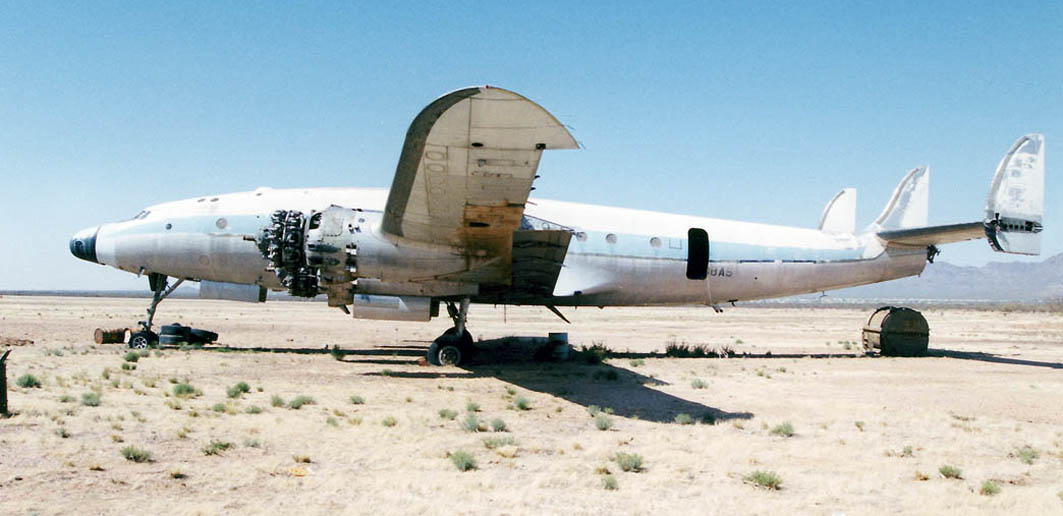
Lockheed Constellation
 |
| N608AS was originally built as an L-749A and entered service with the USAF in 1948 as a VC-121A. |
| For many people the Lockheed Constellation, and
its ultimate development the Starliner, represent the pinnacle of
propeller airliner design - certainly its graceful lines are unrivalled
by any other aircraft of its type. Work on the project began in 1939 when several United States airlines signalled their requirement for a 40 passenger airliner. However, by the time the first prototype flew, on January 9, 1943, the US was deeply involved in war production and the aircraft emerged as the C-69 transport. Fifteen were delivered from an order for 180 by VJ day in 1945. It was in the post-war explosion of air travel, particularly within the USA, that the pressurised Constellation came to the fore and the aircraft was to enjoy a 20-year career in frontline airline service before being eclipsed by turboprops and jets. The C-69 was quickly modified for Pan Am and TWA as the L-049 and the name Constellation was first adopted. Pan Am flew the first Connie service between New York and Bermuda in February 1946. TWA followed this with the first US to Europe flights - to Paris - in the same month and BOAC also bought five for the London-New York route. The early days were not without their problems and a series of engine fires and propeller failures culminated in the type's grounding for modification after a TWA aircraft crashed on a training flight. While the L-049 could seat typically 43 to 48 passengers, or up to 60 at a squeeze, the refined L-649, which entered service with Eastern Airlines in 1947, could carry up to 81, although anything up to 64 was more typical. Lockheed next launched the L-749 - basically a 649 with more fuel capacity - and this found favour on Trans-Atlantic routes. The L-749A introduced a stronger undercarriage for greater weights and was adopted by the USAF, including for use as a presidential transport, and the US Navy, which used it as the PO-1W and WV-1 AEW aircraft. After 221 Constellations were built Lockheed introduced the Super Constellation in 1951 in response to airline demand for greater payload and cheaper operating costs. In comparison to the L-749, the L-1049 prototype had a fuselage lengthened by 18ft 4in (5.59m) and featured Wright Cyclone piston engines of 2,700hp and extra fuel capacity. The first Super Connie took to the skies on October 13, 1951 and the 24 built were split between TWA, with ten, and Eastern, with 14. The L-1049B was a military variant and boyh it and the L-1049C took the design to another level with underpowered piston engines giving way to turbo-compounds. Ten airlines ordered 60 aircraft. The L-1049D was a freighter mainly used by Seaboard and Western while the improved L-1049E quickly gave way to the L-1049G "Super G" with uprated engines. Ninety-nine were built, many carrying distinctive tiptanks. The L-1049G entered service with Northwest Airlines in January 1955 and up to 95 passengers could now be carried. By the time the final Super Constellation variant, the L-1049H, flew on September 20, 1956, the writing was on the wall for the type with rivals Boeing and Douglas working on their 707 and DC8 jet airliners. The H model, of which 53 were built, was a convertible variant and this mark had the distinction of being the last Connie delivered - to Flying Tiger Line in November 1958. By then Lockheed had already developed the ultimate in piston engined airliners - the L-1649A Starliner. Spurred by a requirement from TWA for a Trans-Atlantic airliner capable of competing with Pan Am's DC7Cs, the Starliner was 2ft 7in (0.79m) longer than the Super Constellation, had a new thin-section wing of much greater span and a range of 6,320 miles. Eventually capable of carrying 92 passengers non-stop from New York to London and Paris, the Starliner was nonetheless too late to enjoy commercial success as airlines turned to jets. Only 43 were built and Lockheed never recovered its development costs, which, coupled with only limited success with its turboprop Electra, kept the company off the scene as a major force in airliner manufacturing until the Tristar of the 1970s. Total production of all Constellation and Starliner models was 856. While the Connie faded quickly from frontline airline fleets after 1960, the type was only just embarking on a diverse military career which would see numerous C-121 variants based in the L-1049 enter service with the US Air Force and Navy. These included modifications to give a distinctive hump radome for early warning variants and several variant with rotating AEW radars, which paved the way for the present day E-3 platform. Many of these aircraft remained in service until the late 1970s. Some civil Connies soldiered on into the 1980s as freighters, particularly in Central America and the Caribbean, and in the US and Canada as bug sprayers. None now remaining in commercial service although several fly on with historical groupd in the US, Switzerland and Australia. Lufthansa is currently rebuilding a Starliner to airworthiness in the north-east US and plans to operate it commercially in Europe. |
| Contents | Photos | Census | Update |